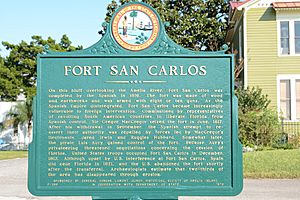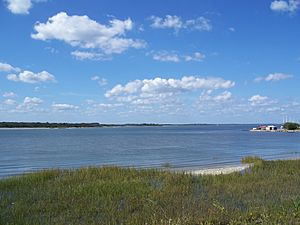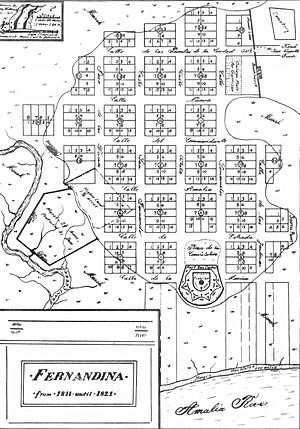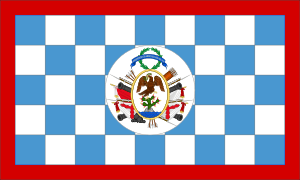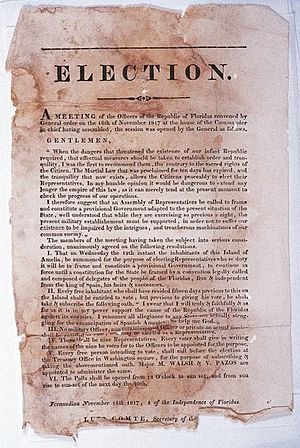Fort San Carlos facts for kids
Fort San Carlos was a military fort built in 1816. Its job was to protect the Spanish town of Fernandina, Florida. This town is now called Old Town. It was located on a piece of land sticking out into the water on the north end of Amelia Island.
The fort was shaped like a "U" and stood on a hill next to the harbor. It looked over the Amelia River. The fort was built from wood and earth walls. It had a wooden fence on one side. The fort was armed with eight to ten cannons. Two small forts, called blockhouses, guarded the land entrance. The whole village was also surrounded by military fences.
A map from 1821 shows that Fernandina's streets were laid out in a grid. This plan was made in 1811 by George J. F. Clarke, a Spanish surveyor. The fort was located where Calle de Estrada, Calle de White, and Calle de Someruelos streets met. Today, the fort is gone, but you can still see traces of it. This area is now part of Fernandina Plaza Historic State Park.
This park holds the largest part of the Spanish town and military site. It dates back to the late 1780s. Scientists have studied the area since the 1950s. They found that people have lived here for about 4,000 years. This includes the ancient Orange period (2000–500 BC). A Spanish guard house was built here in 1696. It was in a Timuqua Native American village. Most of Old Town was built on top of this old village. The site became important for military reasons. It had a deep harbor and was close to the northern border of Spanish Florida.
Contents
History of Fort San Carlos
The story of Fort San Carlos is linked to Fernandina Plaza. This area was first shown on maps in 1769. But by 1777, no town had been built there. The area was empty, except for British soldiers camping sometimes. This was after attacks in 1702 by Colonel James Moore. He was the governor of South Carolina.
Before the British left Florida and it returned to Spanish rule, a woman named Maria Mattair owned land here. She received 200 acres from Governor Tonyn. This land was on the hill overlooking the Amelia River. Amelia Island had very few people after attacks in the 1770s. Maria Mattair and her family were the only ones known to stay.
Maria Mattair owned the town lot from 1784 to 1788. Then, the Spanish government took over the land. In 1795, American rebels attacked the Spanish soldiers on Amelia Island. These rebels were led by Richard Lang. A Spanish officer, Colonel Charles Howard, found that the rebels had built a fort. They were flying the French flag. On August 2, he gathered a large Spanish force. They sailed up the rivers and attacked the rebels. The rebels ran away to Georgia.
The town lot, or plaza, was a key part of Spanish town plans. Government buildings were built to face the plaza. In this coastal town, the plaza could also be used as a defense. An army camp was set up in the Plaza Lot in 1801. A small wooden fort with three cannons was there until 1814. The bigger Fort San Carlos was built around 1816. It was meant to protect the Amelia River harbor and Spanish interests in northern Florida. The old Native American campsite became the fort's parade ground. This area is still there today.
How Fernandina Was Planned
On May 10, 1811, the Spanish governor, Juan José Estrada, gave an order. He told George J. F. Clarke, a new surveyor, to plan the town. This plan had to follow the Spanish Laws of the Indies from 1542. These laws explained how to choose a town site. They also said how to lay out a town in a grid pattern. Specific places were set aside for the fort and its parade ground.
The town was built on high ground behind a large hill. This hill faced the Amelia River. The town was on a wide piece of land with a narrow neck at the southeast. The road to the rest of Amelia Island entered the town through gates there. Egan's Creek and salt marsh were on the north and east sides. Another marsh stretched south of the town.
Across the narrow strip of dry land, there was a strong fence. It had a small blockhouse with two cannons. This guarded the entrance to the town. Another blockhouse on the side of the town had one cannon. Fort San Carlos controlled the Amelia River harbor. It had four large Spanish cannons, five smaller ones, and one carronade.
The Patriots' War
Fernandina was a place for illegal trade. It also seemed to threaten the United States. So, in 1812, forces led by General George Mathews invaded and took over Fernandina. President James Madison approved this. A group of Americans called the "Patriots of Amelia Island" wanted to remove the Spanish. They reported to General Mathews. He moved into a house in St. Marys, Georgia.
On March 16, nine American gunboats lined up in the harbor. They aimed their guns at the town. General Mathews ordered Colonel Lodowick Ashley to demand surrender from Don Justo Lopez. Lopez was the commander of the fort and Amelia Island. Lopez saw that the American force was stronger. He surrendered the Port of Fernandina and the town. The Patriots then raised their own flag at the fort.
The next day, March 17, 250 U.S. troops arrived. The new Patriot government gave the town to General Mathews. He ordered the U.S. flag to be raised. General Mathews and President Madison wanted to add East Florida to the United States. But Congress worried about starting a war with Spain. The plan failed when Secretary of State James Monroe removed Mathews from his job.
Talks to remove U.S. troops began in 1813. On May 6, the U.S. army lowered the flag at Fernandina. They crossed the St. Marys River into Georgia. Spain took back control of the island. The Spanish finished building the new Fort San Carlos in 1816. It was built to guard Fernandina's port.
Gregor MacGregor and the Republic of the Floridas
As the Spanish Empire became weaker, Fernandina was in danger from outsiders. The small group of soldiers at Fernandina had only 54 men. Most were old, and some had served for 30 years. The town had less than 200 people. Only about 50 of them could fight. The town had a lawless feeling when Gregor MacGregor arrived.
MacGregor was a Scottish soldier and mercenary. He claimed to be sent by people from Venezuela and New Granada. They wanted him to free Florida from Spanish rule. American supporters paid for his trip. He led an army of only 150 men. This included soldiers from Charleston and Savannah. Some were veterans from the War of 1812. He also had 55 musketeers.
MacGregor attacked Fort San Carlos. He had spies inside the Spanish fort. He learned that there were only 54 regular soldiers and 50 local fighters. He spread rumors that an army of over 1,000 men was coming. On June 29, 1817, MacGregor and his men attacked. They came from the north and from different directions. This made it look like a much larger force. The commander, Francisco Morales, lowered the Spanish flag and ran away. MacGregor raised his own flag, the "Green Cross of Florida." It was a green cross on a white background. He announced the "Republic of the Floridas."
Now in control of the town, MacGregor wanted to look like a real government. He made Ruggles Hubbard, a former sheriff, the unofficial civil governor. He also made Jared Irwin, a former Congressman, his treasurer. MacGregor hoped for more soldiers to attack a fort in St. Augustine. He wanted to take over all of Spanish East Florida. But his plan was set to fail. President James Monroe was talking with Spain to buy all of Florida.
Soon, MacGregor ran out of money. His "Republic" needed income. He hired privateers to capture Spanish ships. These privateers sold the captured goods and slaves. Around August 28, a helper named Ruggles Hubbard arrived. He had no new men, guns, or money. MacGregor then said he was leaving for the Bahamas. On September 4, he faced a Spanish attack. He still lacked money and soldiers. He gave up his plans to conquer Florida. He left Fernandina with most of his officers. He left a small group of men at Fort San Carlos to defend the island. After he left, these men and American fighters organized by Hubbard and Irwin fought off the Spanish.
The Battle of Amelia Island
On September 13, the Battle of Amelia Island began. The Spanish set up four cannons on McLure’s Hill, east of Fort San Carlos. They had about 300 men and two gunboats. They fired at Fernandina, which Jared Irwin held. His "Republic of Florida" forces had 94 men. They also had two privateer ships, Morgiana and St. Joseph, and an armed schooner, Jupiter.
Spanish gunboats started firing at 3:30 PM. The cannons on the hill also joined in. The guns of Fort San Carlos, on the river hill, and those of the St. Joseph defended Amelia Island. Cannonballs killed two Spanish soldiers and wounded others. The firing continued until dark. The Spanish commander realized he could not capture the island. He then pulled back his forces.
The French Corsair Luis Aury
On September 17, a French privateer named Luis Aury sailed into the Port of Fernandina. He knew MacGregor and had served with him in Simon Bolívar's army. Aury's ship, Mexican Congress, came with two other ships. They carried goods worth $60,000. His ship had 12 large cannons and 300 crew members. These included American recruits and Haitian former slaves.
Aury went to Hubbard’s place with armed men. He demanded control from Hubbard and Irwin. They were short on soldiers and money. They asked for financial help. But Aury refused, unless he could be the supreme commander. He wanted to control both the government and the military. When Hubbard and Irwin disagreed, Aury threatened to leave. They realized they had nothing to gain by fighting him. So, they made a deal. Aury would be the commander-in-chief. Irwin would be his assistant general. Hubbard would be the civil governor.
On September 21, 1817, the flag of the revolutionary Republic of Mexico was raised over Fort San Carlos. This meant Amelia Island was now part of Mexico. Aury created a "Supreme Council of the Floridas." He told his secretaries to write a constitution. He invited all Florida people to join him in fighting Spanish rule.
Florida Joins the United States
The new government of Fernandina did not last long. Aury's privateers captured over $500,000 worth of Spanish goods in two months. They attacked Spanish ships carrying slaves. Most of these slaves were then illegally brought into Georgia. These actions threatened talks about Spain giving Florida to the U.S. In response, President Monroe sent forces to take back Amelia Island on October 31.
After many talks, Aury realized he could not win. He surrendered the island and the fort to Commodore J.D. Henley and Major James Bankhead. This happened on December 23, 1817. Aury stayed for over two months as an unwanted guest. Bankhead occupied Fernandina and held it "in trust" for Spain. Spain was angry about the U.S. getting involved at Fort San Carlos. But they still gave Florida to the U.S. in 1821.
The Adams–Onís Treaty was signed in 1819. On February 22, 1821, it officially transferred East Florida and West Florida to the United States. The U.S. Army did not use the fort much and soon left it.
Fort San Carlos Today
Fernandina, once a place for illegal trade, became quiet. The local Confederate Army used Fort San Carlos during the Civil War (1861–1865). The U.S. military also used it briefly during the Spanish–American War (1898). Experts believe that two-thirds of the fort's area has disappeared. This is due to erosion by the Amelia River.
Today, most of the old town lot is part of Fernandina Plaza Historic State Park. It is a grassy area with a State of Florida Historic Marker. The park is about three meters above sea level and is mostly flat. The land has changed because people lived there and built the fort. But the original Spanish town plan and street grid are still there. Many Spanish street names remain. You can still find traces of the earth walls and the old parade grounds along Estrada Street.
In 1950–51, archaeologists John W. Griffin and Ripley P. Bullen led digs in the Fort San Carlos area. In 1963, Florida State University also taught a field archaeology course at the fort. A report called "Fort San Carlos" was published in 1971. It combined the results of both digs. The Duncan Lamont Clinch Historical Society of Amelia Island wanted the fort to be rebuilt in the future.


